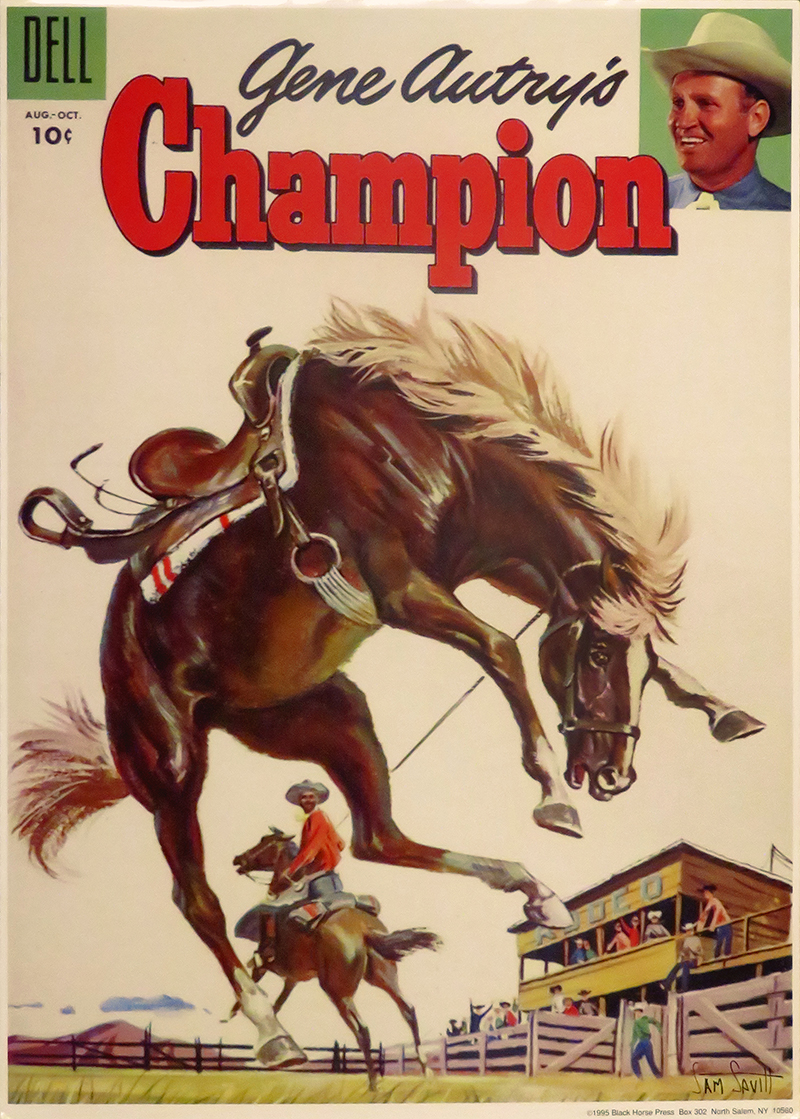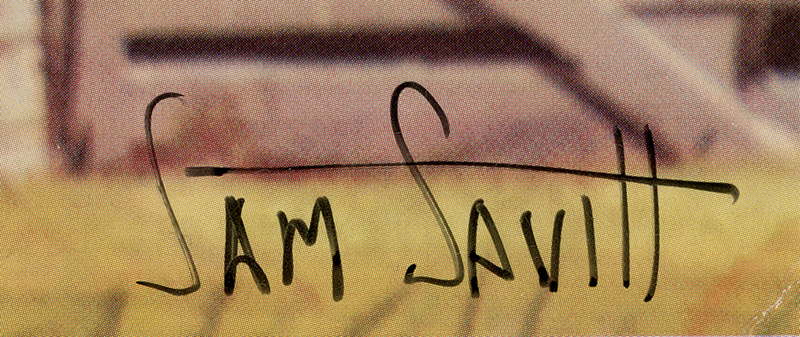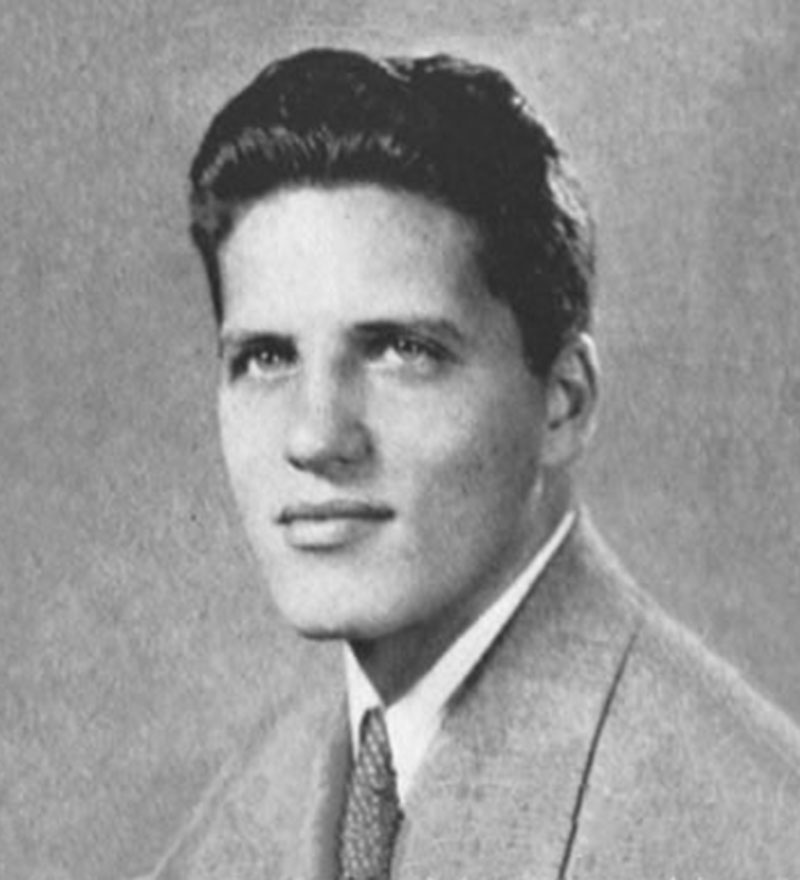|
|
Oversized Print Signed by Artist

Click image to enlarge
13x18-inch print of Gene Autry's Champion comic book cover, Dell No. 19 (Aug.-Oct. 1955), signed by artist Sam Savitt (1917-2000). Original signature in fine-point marker at lower right. Print ©1985 by Black Horse Press of North Salem, N.Y. The comic book was a companion to "The Adventures of Champion" (CBS 1955-1956), which starred Television Champion. (Read about the different Champions.) As described by ComicBookPlus.com, the painted cover image shows Champion bucking in a rodeo ring in the foreground with a lasso about his neck as the rodeo rider, astride his own horse in the background, pulls the rope tight. The crowd looks on; two in the crowd throw their arms up in cheer. This was the cover to a quarterly, 10-cent, 36-page comic copyrighted by Gene Autry, designed and produced by Western Printing & Lithographing Co. This issue included two 17-page stories: "Champion in Dangerous Waters" and "Champion in Fire Trap." The two stories were illustrated by Morris Gollub.
About Sam Savitt (from PulpArtists.com)
Sam Savitt was born Sam Savitz on March 22, 1917, in Wilkes-Barre, Penn., a coal mining town. His father, Hyman Savitz, was born in 1884 in Russia and came to America in 1892. His mother, Rose Eskowitz, was born in 1889 in Austria and came America to 1904. Both of his parents were Jewish. They lived at 52 Hancock Street. They had four children, Sally Savitz (born 1915), Sam Savitz (born 1918), Alfred Savitz (born 1922), and Evelyn Savitz (born 1927). His father worked as a timekeeper at an iron foundry. Although the artist is renowned for his passionate portrayal of horses, there is no significant interaction with horses in his early family history. Nevertheless, he was fascinated by the work horses and mules that labored in his hometown mining community. When the father lost his job at the foundry he became an itinerant salesman. The family was poor, but their greatest loss was the tragic death, while undergoing surgery, of the youngest daughter, Evelyn, at age 12, when Sam was in high school.
Wilkes-Barre was hard hit by the Depression, so most young men left town after graduation. Even as a child, Sam Savitt was a gifted cartoonist. He drew comics for his high school newspaper. After he graduated in 1935 Sam moved to New York City to look for work as a cartoonist. He lived with an uncle in a small Brooklyn apartment. His first freelance assignments were interior pen & ink story illustrations for Action Packed Western, a pulp magazine from Columbia Publications. He signed these early illustrations as Savitts, and later changed his name to Savitt. These jobs for Columbia only paid five dollars for a single spot and nine dollars for a two page spread, but Sam was able to earn a living. He also drew interiors for Fighting Western, Speed Western, Thrilling Ranch, Ranch Romances, Fight Stories, The Rio Kid Western, Popular Western, Masked Rider, Exciting Western, Leading Western, Super Detective, and Triple Western. Sam Savitt was soon able to afford to attend art classes at the Pratt Institute in Brooklyn. He studied with illustrators Nicholas Reily and H. Winfield Scott. To make ends meet, Sam waited on tables and even modeled for art classes. He finally received his diploma in 1941. During World War II, Savitt served in the U.S. Army Corps of Engineers, 352nd Battalion, and became a first lieutenant. He worked on the Ledo-Burma Road project, to resupply the Chinese Nationalist Army of Chiang Kai-Shek in fighting the Japanese occupation of China with Allied war materiel from the Indian seaport of Calcutta. After the war, while recuperating from a case of malaria, he met Bette Orkin at a USO dance in New York City. It was love at first sight, and they married in 1946. They moved to Levittown and raised two children, a daughter, Vicky, and a son, Roger. In the 1950s Sam Savitt worked for Dell comic books, painting covers for many of their titles, including Hi-Yo Silver, Champion, Trigger, The Lone Ranger, and The Cisco Kid. In 1956 the Savitt family bought a fifteen-acre property named "One Horse Farm" in North Salem, NY, where Sam could ride and school horses. In the 1960s he worked for several men's adventure magazines such as Outdoor Life, Real, See For Men, Sports Afield, and True. His drawings appeared in Sports Illustrated, Equus and Practical Horseman. He also wrote and illustrated more than a dozen of his own books about horses. He was the official artist of the U.S. Olympic Equestrian Training Team. In 1998 he received the Lifetime Achievement Award from the North American Horsemen's Association. According to the artist, "The horse is beauty, strength, rhythm, and action. To really know and understand him, to capture his magnificence with pencil or brush, will to me be forever challenging." Sam Savitt died at age 83 on December 1, 2000. — David Saunders 2009 Further reading: For information about Gene Autry's horse(s) named Champion, read My Years With Gene Autry and Melody Ranch by Henry Crowell.
LW2854: 9600 dpi jpeg from autographed print purchased by Leon Worden. |
Brochure 1950s
Aerial & Story 1957
Train Collection
Main Street
Mexican Chapel
Buildings Late 1950s
Hacienda ~1962
Hoppy Invitation 1953
Champion Comic Cover (1955) Signed by Artist
Adventures of Champion at Vasquez Rocks 1955/56
Wichita 1955 (Mult.)
Man From Del Rio 1956 (Mult.)
Gunsmoke 1956
Gunfighters of Abilene, 1960 (Mult.)
Soraya, Ex-Queen of Iran, 1960
|
The site owner makes no assertions as to ownership of any original copyrights to digitized images. However, these images are intended for Personal or Research use only. Any other kind of use, including but not limited to commercial or scholarly publication in any medium or format, public exhibition, or use online or in a web site, may be subject to additional restrictions including but not limited to the copyrights held by parties other than the site owner. USERS ARE SOLELY RESPONSIBLE for determining the existence of such rights and for obtaining any permissions and/or paying associated fees necessary for the proposed use.
















